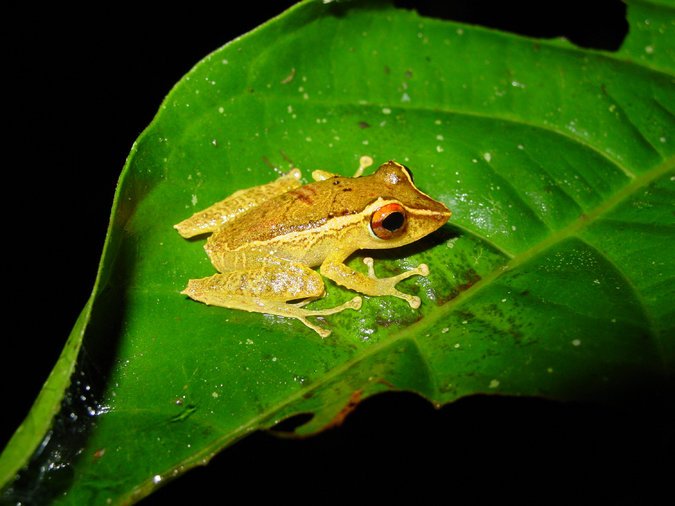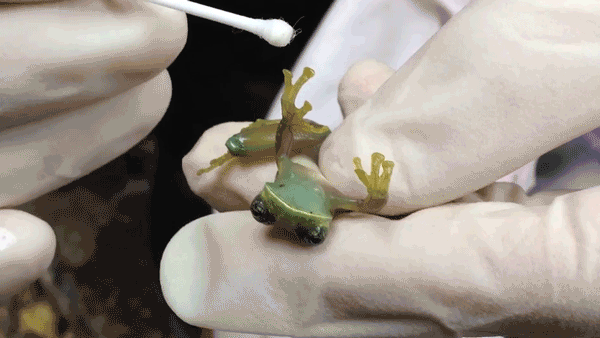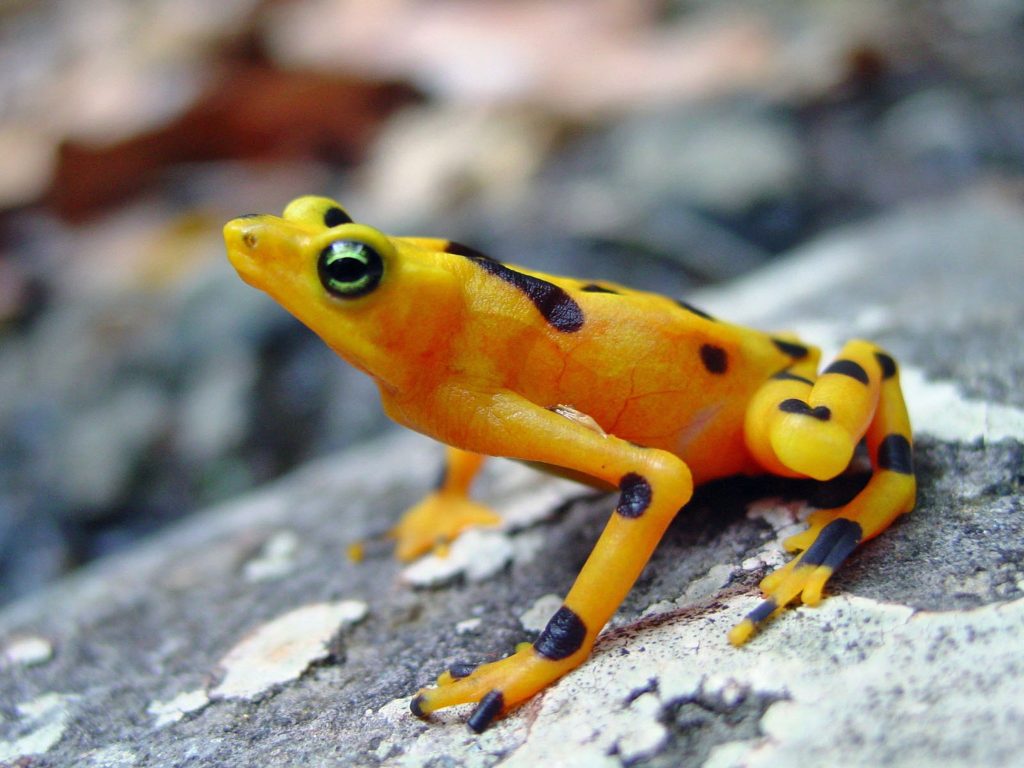A Few Species of Frogs That Vanished May Be on the Rebound
In 2013, two biologists named Jamie Voyles and Corinne L. Richards-Zawacki spent weeks slogging up and down mountainsides in Panama. “We were bug-bitten and beat up,” recalled Dr. Voyles, now an assistant professor at the University of Nevada, Reno.
Near the end of their trek, they came to a stop. In front of them sat the object of their quest: a single gold-and-black frog.
“I can’t tell you what that moment was like,” Dr. Voyles said.
She had feared that variable harlequin frogs had disappeared entirely from Panama. As recently as the early 2000s, they had been easy to find in the country’s high-altitude forests.
“They used to be so abundant that you could barely walk without stepping on them,” Dr. Voyles said.
Advertisement
Continue reading the main story
But in recent years, Dr. Voyles and her colleagues started to encounter sick frogs, and then dead ones. And then they couldn’t find any variable harlequin frogs at all.
Continue reading the main story
Advertisement
Continue reading the main story
Many other species at Dr. Voyles’s research sites in Panama suffered the same grim fate. As had frogs around the world. Dr. Voyles and other frog researchers found that many of the dead frogs were covered with the same aggressive skin fungus, known as Batrachochytrium dendrobatidis or Bd.
As Bd spread from forest to forest, and continent to continent, researchers feared that amphibians might suffer mass extinctions. Today, many species of frogs and toads are still dwindling, and some have disappeared altogether.
But scientists like Dr. Voyles have also found a little cause for hope: a handful of species appear to be coming back. After discovering variable harlequin frogs again, she and her colleagues have returned to their Panama research sites and found a few other species that had previously vanished.
“They’re not in large numbers — their abundances are low,” Dr. Voyles said. “But we think that as more time goes by, we’ll find more species that we thought were lost.”
Now scientists are trying to figure out what accounts for these rebounds. On Thursday, Dr. Voyles and her colleagues published evidence suggesting that the frogs have gained potent defenses in their skin against the fungus.

But other experts are divided about whether the researchers found a cause of the rebound. It’s possible that there are other causes at work. Even climate change — which is posing its own threats to many frog species — may be temporarily helping some frogs withstand the fungus.
When Dr. Voyles rediscovered a few vanished frog species, she initially suspected that the Bd fungus was becoming less deadly. In outbreaks of other pathogens, they have sometimes evolved into milder forms that no longer wipe out the hosts they depend on for their survival.
Advertisement
Continue reading the main story
To test that idea, Dr. Voyles and her colleagues got hold of frozen Bd samples gathered in Panama in 2004, early in the epidemic. They infected frogs with the old fungus, and observed how it compared to new strains of Bd. “It’s still pretty lethal over a decade later,” Dr. Voyles said. “So I was wrong.”
Dr. Voyles was left with the possibility that the frogs themselves had changed. At first she found this idea unlikely, because there hadn’t been much time for the frogs to evolve. While Bd can multiply in a matter of days, it can take many months for a frog to develop into a sexually mature adult.
She tested the hypothesis anyway. Dr. Voyles and her colleagues knew that frogs fight infections with potent skin secretions containing pathogen-killing molecules. Dr. Voyles and other researchers have found that when they add skin secretions to lab-grown Bd, it slows down the fungus’s growth.
Dr. Voyles wondered if frogs had acquired more potent skin secretions, allowing them to rebound. To test that possibility, she and her colleagues collected skin secretions from captive frogs in the Maryland Zoo. The frogs descend from ancestors that had been captured in Panama before the Bd epidemic.
The researchers added skin secretions from captive frogs to petri dishes of growing Bd. They then measured how much the frog’s secretions slowed down the fungus’s growth.
Newsletter Sign Up
Continue reading the main story
Please verify you're not a robot by clicking the box.
Invalid email address. Please re-enter.
You must select a newsletter to subscribe to.
Sign Up You agree to receive occasional updates and special offers for The New York Times's products and services.
Thank you for subscribing.
An error has occurred. Please try again later.
You are already subscribed to this email.
View all New York Times newsletters.
- See Sample
- Manage Email Preferences
- Not you?
- Privacy Policy
- Opt out or contact us anytime
They then carried out the same treatment with skin secretions taken from rebounding populations of wild frogs. The researchers found a big difference between the two trials.
“We had multiple species that were between two and fivefold different in their effectiveness,” said Dr. Voyles, “which is pretty striking.”
Dr. Voyles speculated that some species of frogs included a few mutants with skin secretions that were effective against Bd. While many other frogs died off, the mutants survived and passed down their defensive genes.
James P. Collins, an evolutionary ecologist at Arizona State University, said he found Dr. Voyles’s explanation compelling. “This would be the first candidate I’d put on the table,” he said.

But Karen R. Lips of the University of Maryland wasn’t persuaded that the researchers made a convincing case for skin secretions. “They don’t actually provide data that really supports that,” she said.
Advertisement
Continue reading the main story
To determine how much good skin secretions do, Dr. Lips said, it would be necessary to infect frogs and see whether stronger skin secretions actually keep more frogs alive.
Dr. Lips’s skepticism comes from her own research on frog defenses. In some of her studies, she focuses not on skin secretions, but on the genes involved in the frog immune system.
She and her colleagues have found that some frogs respond to infections by switching on many of these genes and using them to make lots of immune-related proteins. But those frogs all die, along with the frogs that have a weaker genetic response.
“Their genes are going crazy, but it doesn’t matter,” Dr. Lips said.
It’s possible that the immune system of frogs will turn out to be a key to the rebound of some species, or their skin secretions — or both. It’s also possible that other factors matter.
The Bd fungus can grow only in cool temperatures. If some frogs moved down to lower altitudes where it’s warmer, they might be spared.
“You wind up selecting for animals that like to live in some spots as opposed to animals that live in cooler, shady spots,” Dr. Collins said.
In some places, the frogs may not even have to move to gain this protection. In February, a team of Spanish researchers reported that three species of frogs in Spain are growing in numbers, even though Bd is present in the country and it can infect all the species there. They conclude that global warming is raising the temperature where the frogs live, keeping the fungus in check.
Advertisement
Continue reading the main story
In these cases, the frogs may be getting only a temporary reprieve. Their habitats may eventually get too hot not only for the fungus, but for the frogs themselves.
“The skin secretion part of the story is probably not the only thing that’s going on,” Dr. Voyles acknowledged. “There’s probably lots of different reasons why different species have survived and, in some cases, recovered.”
Dr. Voyles also emphasized that the recovery of a few species was no reason to lean back and assume that nature would take care of the Bd crisis.
“I want to put out the message that this is still bad,” she said. The rebound, she argues, “definitely is a glimmer of hope. But it does not mean by any means that everything is back and there is no problem.”
Follow Carl Zimmer on Twitter @carlzimmer
Like the Science Times page on Facebook. | Sign up for the Science Times newsletter.
Continue reading the main storyRead the Original Article






























